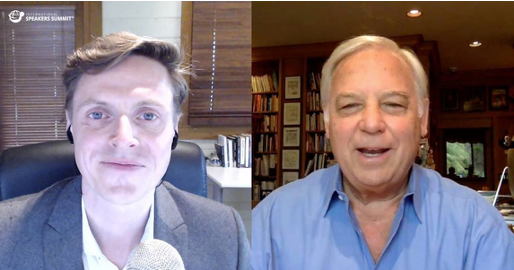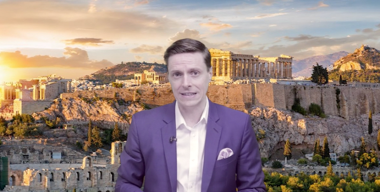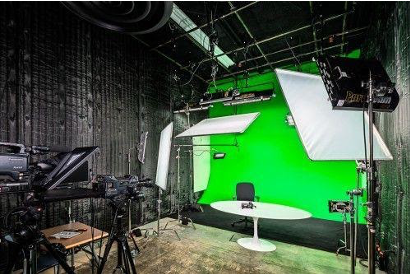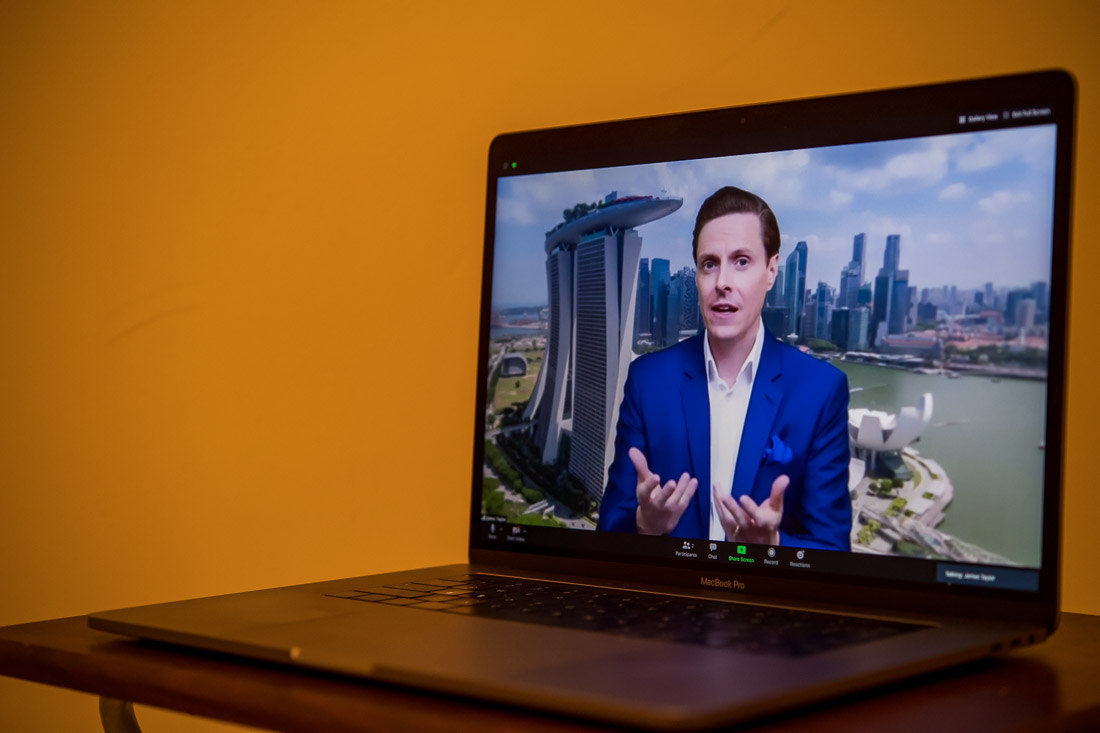HOW TO FIND A TOP VIRTUAL KEYNOTE SPEAKER FOR YOUR NEXT VIRTUAL MEETING OR EVENT

Done well, virtual meetings and events can be a highly effective way to inspire, inform and educate your people. However we’ve all had to sit through those rather long and boring virtual meetings, conferences, summits, webinars and events which quite frankly deliver a very low return on investment in terms of time and money.
So how can you create a more creative, engaging and interactive virtual meeting, conference, summit or c-suite briefing?
How can you find the best virtual keynote speaker to inspire and engage your audience?
As a virtual keynote speaker on business creativity, innovation and artificial intelligence I’ve had the pleasure to deliver both in-person or virtual keynotes for clients including IBM, Apple, EY, TATA and VISA.
Meanwhile as a virtual emcee, presenter or host who has interviewed over 500 CEOs, innovators and celebrity speakers for multiple online summits I’ve also had the opportunity to work with some of the world’s top virtual keynote speakers.
In this briefing I’d like to share with you what I learned and provide you with tips to create more immersive virtual meetings, conferences or events.
START WITH WHY
The management theorist Peter Drucker once said, “the most common source of mistakes in management decisions is the emphasis on finding the right answer rather than the right question”.
Often when I talk with clients who are pivoting to virtual events or conferences they want to immediately discuss the format. However it’s important to first ask yourself a series of questions to really understand why you are doing virtual events in the first place.
So let’s approach your virtual event design in a more curious, creative, innovative and questioning way.
WHY VIRTUAL EVENTS
Why should you do a virtual event in the first place? Why shouldn’t we hold off and wait to do a traditional in-person event next quarter or next year?
We all know that COVID-19 (coronavirus) has resulted in global travel bans and made it more difficult for you to bring your team, clients and partners together to share insights, opportunities, updates and ideas.
However there is a more strategic reason for pivoting to virtual events and it relates to one of the biggest challenges global companies have today… to reduce their carbon footprint. Pandemics are the immediate problem but from a longer and more strategic standpoint I believe the number one reason to pivot to virtual meetings or events is because they make sense from a corporate social responsibility standpoint as organisations look for ways they can address the climate emergency.
Now don’t get me wrong there are many other positive side effects for making your next event virtual or hybrid. If you are reading this and you are a senior executive you know how valuable your time is. If you are based in Singapore and have to attend your company leadership conference in London then you are looking at 48 hours travel time not to mention the jetlag. Virtual events instantly save you travel and opportunity costs while in the process enable you to inspire, educate and inform your key stakeholders.
And while we are on the topic of savings we shouldn’t discount the fact that large live in-person events eat up a huge amount of financial and human resources. Virtual events cost a fraction of producing live events as they benefit from:
- Lower cost per attendee or participant
- Flexibility (virtual events can range from 20 to 20,000 attendees for the same costs)
- Speed (you can create, launch and deliver a virtual conference in under 30 days)
- Accessibility (watch anywhere and on any device)
- Evergreen (you can turn the recordings into training content for your employees)
- Lower fixed costs (no travel, hotel, venue hire, food costs)
- Confidentiality (control exactly who has access to the online content)
- Global (easy to bring in virtual keynote speakers and panellists from around the world)
TYPES OF VIRTUAL MEETINGS & EVENTS
Let’s assume you know you are going to make your next event, conference or leadership meeting virtual. Now you can ask a series of questions to help you define what kind of virtual event is right for your audience. The most popular types of virtual meetings and events are:
- Virtual Summits or Conferences
- Hybrid Events (more about that later)
- Virtual Trade Shows
- Virtual Company Meetings (e.g. C-Suite Briefings, AGM’s, Leadership Meetings, Sales Kickoffs)
- Online Learning
- Virtual Workshops, Masterclasses and Webinar Series
- Product Launches
With my futurist keynote speaker hat on I believe Hybrid Events provide the most flexibility and highest ROI for the kinds of clients that bring me in to deliver keynote speeches (mostly mutli-national companies, industry associations and national governments).
A Hybrid Event is a conference, company meeting, or trade show that combines live, in-person elements with virtual components. For example, a business conference that hosts an in-person gathering in London and live-streams its keynotes, workshops and sessions to a global virtual audience would be considered a hybrid event.
Both the speakers and the attendees can be in-person or virtual. So for example you may have three speakers who present in-person and two who present virtually from their home studio or office. Likewise the attendees or audience can be in-person or virtual. Some may decide to travel to attend in-person while others will attend virtually because of time, costs, visa or health constraints. These all-weather hybrid events work well during economic storms, political gales, global pandemics and travel bans.
VIRTUAL EVENT HOST/MODERATOR
Perhaps one of the least understood elements of virtual events is that more of your event budget will be spent on your on-screen talent (emcee, keynote speakers, panel moderators) and less on technical event production. Unlike in-person events, virtual events don’t require large audio and visual setups. You will likely choose one of the popular virtual event platforms (e.g. Zoom, CISCO Webex, Adobe Connect) based upon your requirements.
Choosing a professional virtual event emcee or host is critical to the success of your event. The good ones combine the presentational and improvisational abilities of a live TV News anchor with the technical skills of a SpaceX flight engineer. Many of them have backgrounds in live radio or TV presenting so they have the ability to look like a swan gliding on a calm lake while at the same time making the virtual attendee oblivious to the technical issues going on beneath the water line.
I have hosted and emceed multiple large-scale virtual conferences and summits with the largest attracting over 22,000 people across 80 countries. To date I’ve personally interviewed or facilitated fireside chats and panels with over 500 experts from the worlds of business, politics, media, arts and technology.
A good virtual emcee will spend days in content and technical preparation for an event. They are the glue that will hold your virtual event together. When I emcee virtual meetings or events I live by this quote from the British actor Michael Caine, “the preparation is the work, the performance is the play.”
VIRTUAL EVENT STUDIO SETUPS
Regardless of whether you hire a top virtual keynote speaker or an experienced virtual emcee they should have a broadcast quality office studio. If you look at the professional keynote speakers who do a lot of virtual events it will not be uncommon that they will have spent $30,000-$150,000 on their studios.
There are three main types of studio setups or looks that virtual keynote speakers and emcees will use:
- Virtual Presenter Setup
- Virtual Trainer Setup
- Virtual Keynote Speaker Setup
The Virtual Presenter Setup is used mostly by professional emcees and hosts. It is the classic person in front of the bookcase look and works well whether your on screen talent is giving a c-suite briefing, simple speech or media interview. Here is an example of a split screen version of me interviewing best-selling author and Speaker Hall of Fame inductee Jack Canfield for International Speakers Summit:

Next we have the Virtual Trainer Setup. These are used mostly by those who deliver training virtually such as a virtual workshop, masterclass or webinar series. When I deliver virtual masterclasses I prefer to stand, partly for aesthetic reasons but mainly because it allows me to keep the energy high for longer sessions. Below is an image of Virtual Trainer Setup in my office studio.

Whether your L&D/HR team deliver in-house virtual training or you bring in an external virtual trainer I would suggest a setup which in addition to Virtual Presenter Setup would also include a second camera, a widescreen TV, whiteboard or flipcharts, better lighting, wireless lavalier microphone and in-ear monitor. Let me explain why you need those.
The human eye likes a little variety to keep us interested. This is especially the case with virtual presentations. By having two cameras you can switch between a wide shot, a close-up and your Powerpoint presentation. Including a widescreen TV (to show your slides), whiteboard or flipcharts gives the trainer the tools to improve interaction with the virtual attendee.
As the virtual trainer is standing and not sitting they need to be able to move around without any cables trailing behind them. A wireless lavalier microphone and a broadcast quality in-ear monitor allows the presenter to add more movement and dynamics to their training. It also enables them to hear any direction coming from an event director or live translation during Q&A sessions.
And finally we have the Virtual Keynote Speaker setup. The big difference here is that when I deliver a virtual keynote speech in addition to the multiple cameras I will also use a green screen. This allows me to display my Powerpoint slides behind me, change the backdrop, and add overlay text and animations to my live virtual keynote.


A high quality studio setup like this is only used by the top virtual keynote speakers. So when selecting a speaker for your next virtual event it pays to ask a little about the speakers studio setup and ideally see some video footage.
INCREASING INTERACTIVITY DURING VIRTUAL EVENTS
This is one of the biggest differences between in-person and top virtual keynote speakers. With in-person keynotes it tends to be more about ‘the sage on the stage’. With virtual keynotes however you also need a speaker who can be ‘the guide on the side’.
Put simply, virtual meetings or events require you to add more interactivity if you want to use the medium well. Here are just a few ways that I build interactivity into my virtual keynotes:
- Breakout Rooms (allows you to split your audience into smaller rooms for them to interact with each other)
- Polling
- Q&A’s (see below)
- Chat
- Gamification (badges, awards)
- Highlighting Top Comments
And those are just ideas for adding interactivity during the event itself. You can also get very creative about increasing interaction between the attendees pre and post the virtual event. It’s not uncommon that a client will ask me to give a virtual keynote and then afterwards do a small virtual meet and greet session with the event sponsors or VIP’s.
TOP VIRTUAL KEYNOTE SPEAKER TIMING/DURATION
If in doubt, go shorter. In the past I would often be asked to give a 60 minute in-person keynote; 45 minutes of presentation and 15 minutes of Q&A with the audience. This format doesn’t work quite as well in the virtual world.
As well as Zoom fatigue there is an even better reason for doing shorter virtual keynotes. Questions! You see in a 1,000 person live event you might get 5-10% of people who raise their hands to ask a question. With a virtual presentation it’s not uncommon to have 20-30% of attendees who want to ask the speaker a question. This is good news for the audience, speaker and event organiser.
For example I recently gave a virtual keynote where there were 2,500 people in attendance. Instead of doing a 45min presentation and 15min Q&A I suggested to the event organiser we do a 30min presentation and 30min Q&A. After I gave my half hour keynote we received nearly 200 questions from the participants. Thankfully they had also hired a great virtual emcee who was able to see the common questions and I managed to answer 20 questions in the time available.
So go shorter for the keynote part but give your speaker lots of time for Q&A.
PREPARATION SECRETS OF A TOP VIRTUAL KEYNOTE SPEAKERS
As I’ve already mentioned I’m a big fan of preparation. There are three types of preparation that I put into every virtual keynote I give.
Firstly when a client has booked me to speak I will do a pre-event call with the client and a representative from JLA. On the call I ask a LOT of questions including but not limited to:
- What are your virtual event objectives?
- What is the event theme?
- Who will be attending (audience avatar)
- Audience demographics, psychographics and seniority level
- Which speakers have their audience liked in the past and why?
- What is keeping their audience members awake at night? (client challenges)
- What have been the most significant events in your company/industry this year
- What are the timings?
- Who is speaking before and after me?
- Who is the event emcee or host?
- What type of event format is it? (virtual conference keynote, c-suite briefing, etc)
- What technology platform are they using?
- How do they want the audience to feel at the end of my keynote?
- What is their #1 goal for my presentation?
- Do you need to review my presentation in advance? If so by when?
- What date/time do you want to schedule the technical check for?
Secondly I start researching the company and the trends within the client's industry. I also look at the annual reports for both the company and their top three competitors. I then use artificial intelligence to research the likely participants at the virtual event so I can better understand the psychometrics of the audience. You can learn how I do that here. And finally I start writing and rehearsing the keynote itself.
Thirdly we will do a technical check (usually the day before) where I walk the client through my presentation and we check any slides, videos, polling questions and the final agenda and timings. For very high profile virtual events I will also offer to pre-record my entire keynote in case they have any technical issues on the day.
NEXT STEPS
Hopefully I’ve helped demystify the process of producing successful virtual events and working with top virtual keynote speakers and emcees.
If you are interested in inviting me to give a virtual keynote or act as virtual emcee/host for your next event or meeting then you can learn more about the topics I speak on HERE.
ABOUT TOP VIRTUAL KEYNOTE SPEAKER JAMES TAYLOR
James Taylor M.B.A. F.R.S.A. - who started his career managing high profile rock stars - is now an in-demand keynote speaker and internationally recognized leader in business creativity, innovation and artificial intelligence. For over 20 years, he has been advising CEO’s, entrepreneurs, educators, governments and leaders from Silicon Valley to Singapore on how to build innovative organizations, unlock creative potential, and increase productivity.
As the host of multiple virtual summits he has personally interviewed over 500 of the world’s leading creative minds including Silicon Valley tech CEO’s, New York Times bestselling authors, and artificial intelligence pioneers. Hundreds of thousands of people in over 120 countries have learned about creativity and innovation through his online courses, videos, media interviews and keynote speeches.
His clients have included Fortune Global 500 companies, government policy makers, industry associations, and he was recently the subject of a 30 minute BBC documentary about his life and work. He was awarded the S.D. Southern Prize from Canadian energy services company ATCO, the Award for Excellent from Geneva Group International and named 'ONTRApreneur of the Year’ from U.S. business and marketing automation leaders ONTRAPORT.
James is also a Fellow of the Royal Society of the Arts (F.R.S.A.) whose Fellows have included global innovators and leaders including President Benjamin Franklin, Sir Tim Berners-Lee, Bob Dylan, Adam Smith, Nelson Mandela and Professor Stephen Hawking.


